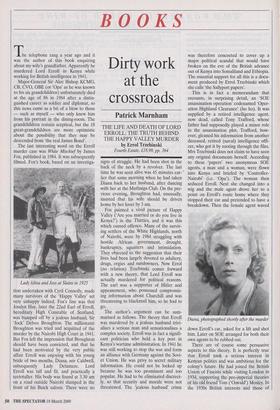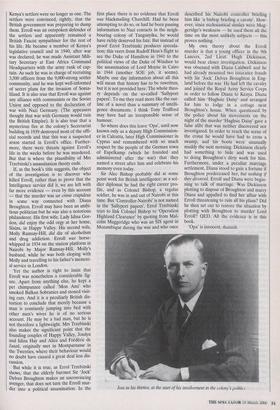BOOKS
Dirty work at the crossroads
Patrick Marnham
THE LIFE AND DEATH OF LORD ERROLL: THE TRUTH BEHIND THE HAPPY VALLEY MURDER by Errol Trzebinski Fourth Estate, £18.99, pp. 364 The telephone rang a year ago and it was the author of this book enquiring about my wife's grandfather. Apparently he murdered Lord Erroll in Kenya while working for British intelligence in 1941.
Major-General Sir Alec Bishop KCMG, CB, CVO, OBE (or `Opa' as he was known to his six grandchildren) unfortunately died at the age of 86 in 1984 after a distin- guished career as soldier and diplomat, so this news came as a bit of a blow to those — such as myself — who only knew him from his portrait in the dining-room. The grandchildren remain sceptical, but the 18 great-grandchildren are more optimistic about the possibility that they may be descended from 'the real James Bond'.
The last interesting word on the Erroll murder case was White Mischief by James Fox, published in 1984. It was subsequently filmed. Fox's book, based on an investiga- Lady Idina and Joss at Slains in 1925 tion undertaken with Cyril Connolly, made many survivors of the 'Happy Valley' set very unhappy indeed. Fox's line was that Josslyn Hay, later the 22nd Earl of Erroll, hereditary High Constable of Scotland, was bumped off by a jealous husband, Sir `Jock' Delves Broughton. The millionaire Broughton was tried and acquitted of the murder by the Nairobi High Court in 1941. But Fox left the impression that Broughton should have been convicted, and that he had been motivated by the very public affair Erroll was enjoying with his young bride of two months, Diana, nee Caldwell, subsequently Lady Delamere. Lord Erroll was tall and fit, and practically a teetotaller. His body was found at 3.30 am on a road outside Nairobi slumped in the front of his Buick saloon. There were no signs of struggle. He had been shot in the back of the neck by a revolver. The last time he was seen alive was 45 minutes ear- lier that same morning when he had taken Diana back to her husband, after dancing with her at the Muthaiga Club. On the pre- vious evening, Broughton had, unusually, insisted that his wife should be driven home by her lover by 3 am.
Fox painted a vivid picture of Happy Valley (`Are you married or do you live in Kenya?') in the Thirties, and it was this which caused offence. Many of the surviv- ing settlers of the White Highlands, north of Nairobi, were by 1984 struggling with hostile African government, drought, bankruptcy, squatters and intimidation. They objected to the suggestion that their lives had been largely devoted to adultery, drugs, orgies and sundowners. Now Errol (no relation) Trzebinski comes forward with a new theory, that Lord Erroll was actually murdered for political reasons. The earl was a supporter of Hitler and appeasement, who possessed compromis- ing information about Churchill and was threatening to blackmail him, so he had to go.
The author's argument can be sum- marised as follows. The theory that Erroll was murdered by a jealous husband trivi- alises a serious man and sensationalises a complex society. Erroll was in fact a signifi- cant politician who held a key post in Kenya's wartime administration. In 1941 he was still working to stop the war and form an alliance with Germany against the Sovi- et Union. He was privy to secret military information. He could not be locked up because he was too prominent and too popular. He had to be eliminated discreet- ly, so that security and morale were not threatened. The 'jealous husband' crime was therefore concocted to cover up a major political scandal that would have broken on the eve of the British advance out of Kenya into Somaliland and Ethiopia. The essential support for all this is a docu- ment produced by Errol Trzebinski which she calls 'the Sallyport papers'.
This is in fact a memorandum that recounts, in surprising detail, an `SOE assassination operation' codenamed 'Oper- ation Highland Clearance' (ho ho). It was supplied by a retired intelligence agent, now dead, called Tony Trafford, whose father had supposedly played a minor role in the assassination plot. Trafford, how- ever, gleaned his information from another deceased, retired (naval) intelligence offi- cer, who got it by rooting through the files. Mrs Trzebinski does not claim to have seen any original documents herself. According to these 'papers' two anonymous SOE agents, a man and a woman, were flown into Kenya and briefed by 'Controller- Nairobi' (i.e. `Opa'). The woman then seduced Erroll. Next she changed into a wig and the male agent drove her to a point on Erroll's route home where they stopped their car and pretended to have a breakdown. Then the female agent waved Diana, photographed shortly after the murder down Erroll's car, asked for a lift and shot him. Later on SOE arranged for both their own agents to be rubbed out.
There are of course some persuasive aspects to this theory. It is perfectly true that Erroll took a serious interest in Kenyan politics and was ambitious for the colony's future. He had joined the British. Union of Fascists while visiting London in 1934, supporting the pro-imperial theories of his old friend Tom (`Oswald') Mosley. In the 1930s British interests and those of Kenya's settlers were no longer as one. The settlers were convinced, rightly, that the British government was preparing to dump them. Erroll was an outspoken defender of the settlers and apparently remained a British Fascist sympathiser for the rest of his life. He became a member of Kenya's legislative council and in 1940, after war was declared, he was made Assistant Mili- tary Secretary at East Africa Command Headquarters with the army rank of cap- tain. As such he was in charge of recruiting 3,500 officers from the 9,000-strong settler community, and he was kept well-informed of secret plans for the invasion of Soma- liland. It is also true that Erroll was against any alliance with communists or the Soviet Union and opposed to the declaration of war with Nazi Germany. (The appeasers thought that war with Germany would ruin the British Empire). It is also true that a mysterious fire at the colony's Secretariat building in 1939 destroyed most of the offi- cial records and that this was a suspected arson started in Erroll's office. Further- more, there were threats against Erroll's life in the weeks before he was murdered. But that is where the plausibility of Mrs Trzebinski's assassination theory ends.
If, as the book's title suggests, the object of the investigation is to discover who killed Erroll, rather than to prove that the Intelligence service did it, we are left with far more evidence — even by this account — that the murder was un crime crapuleux in some way connected with Diana Broughton. Erroll may have been an ambi- tious politician but he was also a notorious philanderer. His first wife, Lady Idina Gor- don, did enjoy the odd orgy at her home, Slains, in Happy Valley. His second wife, Molly Ramsay-Hill, did die of alcoholism and drug addiction. Erroll was horse- whipped in 1934 on the station platform in Nairobi by Major Ramsay-Hill, Molly's husband, while he was both eloping with Molly and travelling to his father's memori- al service in London.
Yet the author is right to insist that Erroll was nonetheless a considerable fig- ure. Apart from anything else, he kept a pet chimpanzee called 'Mon Ami' who smoked Balkan Sobranies and stoned visit- ing cars. And it is a peculiarly British dis- tortion to conclude that merely because a man is constantly jumping into bed with other men's wives he is of no serious account. He may be a bad man, but he is not therefore a lightweight. Mrs Trzebinski also makes the significant point that the founding couples of Happy Valley, Josslyn and Idina Hay and Alice and Frederic de Janze, originally met in Montparnasse in the Twenties, where their behaviour would no doubt have caused a great deal less dis- cussion.
But while it is true, as Errol Trzebinski shows, that the elderly baronet Sir 'Jock' Delves Broughton makes an unconvincing avenger, that does not turn the Erroll mur- der into a political assassination. In the first place there is no evidence that Erroll was blackmailing Churchill. Had he been attempting to do so, or had he been passing information to Nazi contacts in the neigh- bouring colony of Tanganyika, he would have richly deserved his fate. But instead of proof Errol Trzebinski produces specula- tion; this veers from Rudolf Hess's flight to see the Duke of Hamilton in 1941 to the political views of the Duke of Windsor to the assassination of Lord Moyne in Cairo in 1944 (another SOE job, it seems). Maybe one day information about all this will mean that history has to be rewritten, but it is not provided here. The whole theo- ry depends on the so-called `Sallyport papers'. To me they read more like the out- line of a novel than a summary of intelli- gence documents. I think Tony Trafford may have had an irresponsible sense of humour.
So where does this leave `Opa', until now known only as a deputy High Commission- er in Calcutta, later High Commissioner in Cyprus and remembered with so much respect by the people of the German town of Espelkamp (which he founded and administered after the war) that they named a street after him and celebrate his memory even today.
Sir Alec Bishop probably did at some point work for British intelligence; as a sol- dier diplomat he had the right career pro- file, and as Colonel Bishop, a regular soldier, he was in and out of Nairobi at this time. But 'Controller-Nairobi' is not named in the `Sallyport papers'. Errol Trzebinski tries to link Colonel Bishop to 'Operation Highland Clearance' by quoting from Mal- colm Muggeridge who was an SIS agent in Mozambique during the war and who once described his Nairobi controller briefing him like 'a bishop briefing a curate'. How- ever, since ecclesiastical similes were Mug- geridge's weakness — he used them all the time on the most unlikely subjects — this proves nothing.
My own theory about the Erroll murder is that a young officer in the 9th Lancers, 2nd Lieut. Hugh Dickinson, would bear closer investigation. Dickinson was obsessed with Diana Caldwell and he had already mounted two insurance frauds with Sir 'Jock' Delves Broughton in Eng- land before the war. He had left the cavalry and joined the Royal Army Service Corps in order to follow Diana to Kenya. Diana called him 'Hughsie Daisy' and arranged for him to lodge in a cottage near Broughton's house. When questioned by the police about his movements on the night of the murder 'Hughsie Daisy' gave a false alibi that was neither discovered nor investigated. In order to reach the scene of the crime he would have had to cross a swamp, and his boots were unusually muddy the next morning. Dickinson clearly had something to hide and was used to doing Broughton's dirty work for him. Furthermore, under a peculiar marriage settlement, Diana stood to gain a fortune if Broughton predeceased her, but nothing if they divorced. Erroll and Diana were begin- ning to talk of marriage. Was Dickinson plotting to dispose of Broughton and marry Diana and appalled to find her affair with Erroll threatening to ruin all his plans? Did he then set out to restore the situation by plotting with Broughton to murder Lord Erroll? QED. All the evidence is in this book.
`Opa' is innocent, dammit.
Joss in his thirties, at the start of his involvement in the colony's politics



















































































 Previous page
Previous page